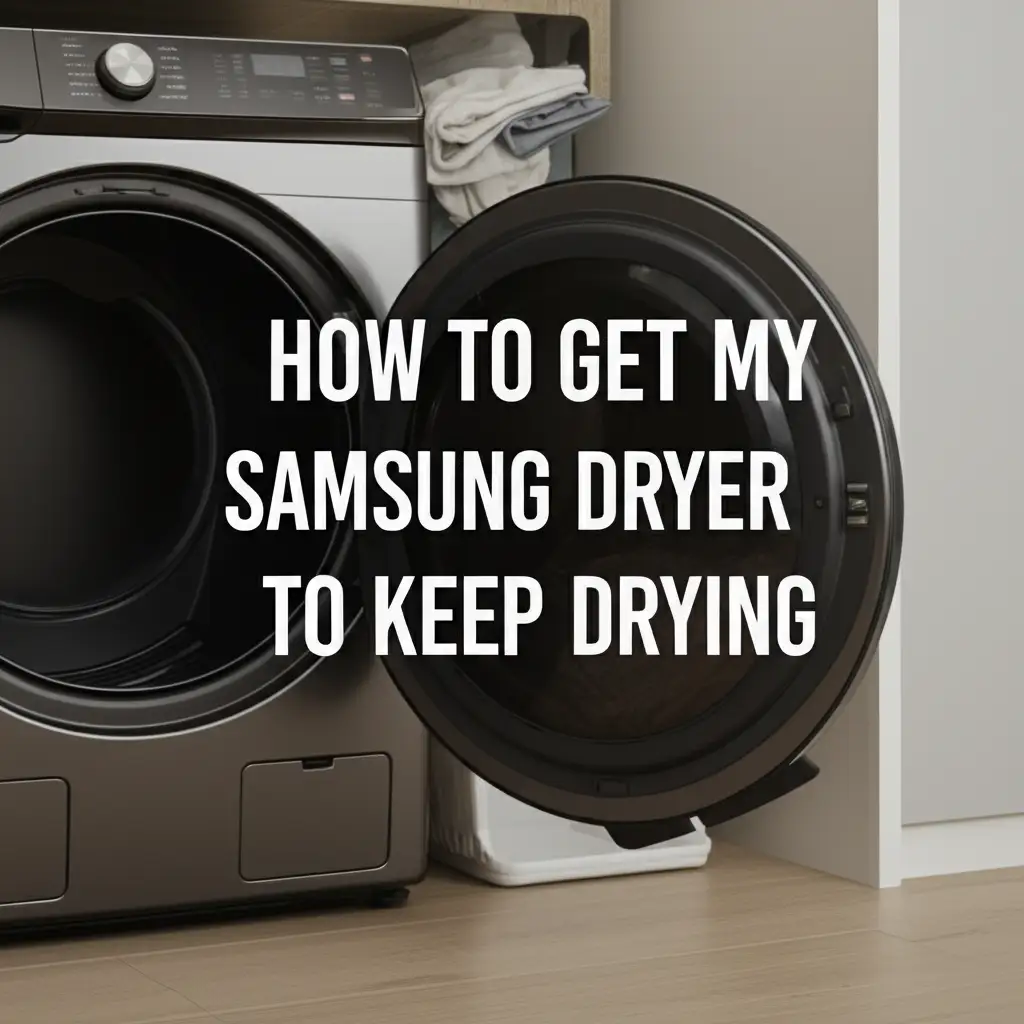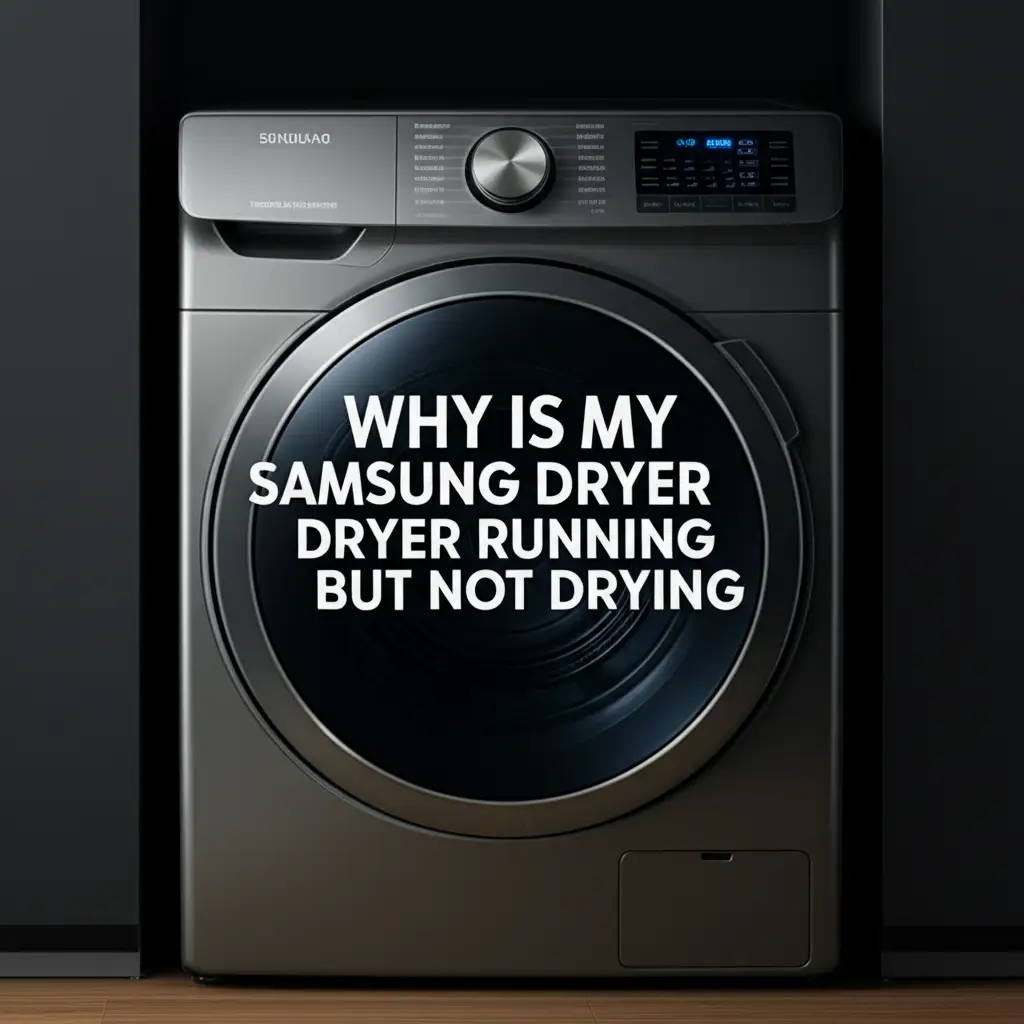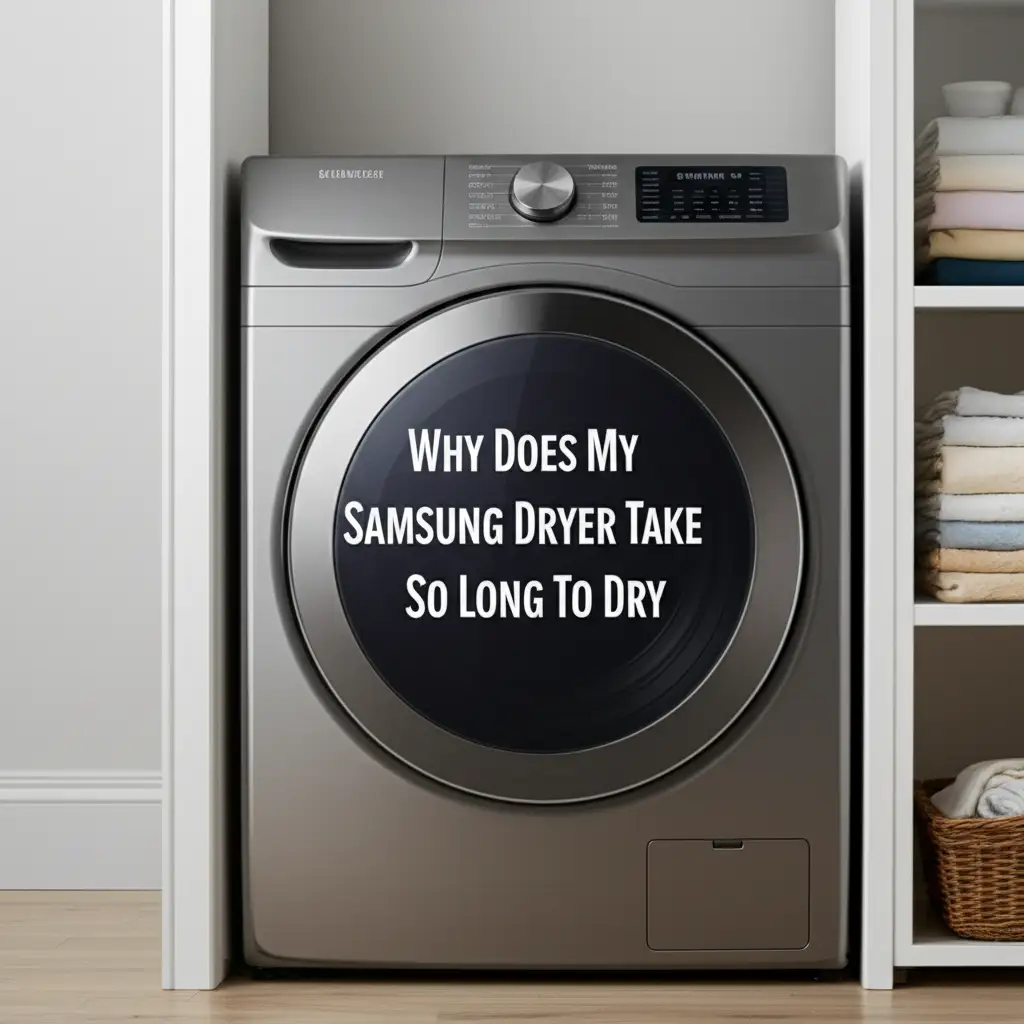· Todd Martin · Appliance Repair · 17 min read
How To Get My Samsung Dryer To Keep Drying

How to Keep Your Samsung Dryer Drying Consistently
There is nothing more frustrating than opening your dryer door, expecting to find warm, dry clothes, only to discover they are still damp. Many Samsung dryer owners experience this issue: the machine starts, tumbles, but fails to complete the drying cycle effectively, or it simply stops drying altogether. You might wonder, “How do I get my Samsung dryer to keep drying?” This common problem often stems from simple, fixable issues rather than a major appliance breakdown. I understand your annoyance, and I am here to help.
In this comprehensive guide, I will show you common reasons your Samsung dryer might stop drying and provide clear, actionable steps to troubleshoot and resolve these issues. We will cover everything from basic maintenance tasks, like cleaning your lint filter, to inspecting critical components, such as heating elements and sensors. My goal is to help you restore your Samsung dryer’s performance and ensure your clothes come out perfectly dry every time. Let’s get your dryer working like new again.
Takeaway
- Clean Lint Filter: Remove lint from the filter before every load.
- Inspect Venting System: Check the dryer vent for blockages and kinks.
- Clean Moisture Sensors: Remove residue from the dryer’s moisture sensors.
- Verify Power Supply: Ensure the dryer has proper electrical power.
- Check for Overloading: Avoid stuffing too many items into the drum.
Your Samsung dryer stops drying primarily due to airflow restrictions, sensor inaccuracies, or a failing heating component. Clear the lint filter, inspect the dryer vent for clogs, clean the moisture sensors, and check the heating element to restore proper drying function. Regular maintenance helps prevent future issues.
Understanding Your Samsung Dryer’s Drying Process
A Samsung dryer works by cycling hot air through the drum to evaporate moisture from clothes. It then expels this moist air through a vent system. This process requires three main things: heat, airflow, and a way to sense when clothes are dry. Samsung dryers use moisture sensors to detect dampness. These sensors tell the control board when clothes are dry, allowing the dryer to end the cycle. If any part of this system fails, your Samsung dryer will not keep drying properly.
I find that understanding the basics makes troubleshooting much easier. When your dryer does not dry clothes, it means one of these elements is not working as it should. It might not be getting hot enough, or air might not flow freely. The sensors might also report incorrect data to the control panel. Knowing this helps you focus your efforts. My experience shows that most issues are simple blockages or sensor problems.
Your Samsung dryer’s design prioritizes efficiency and safety. It will shut down if it detects overheating or if it cannot sense moisture properly. This prevents damage to the unit and reduces fire risk. Thus, a dryer that stops drying is often a safety response, not just a malfunction. We need to identify which part of this complex system is failing. Let’s explore the specific components involved in drying and how they might contribute to your problem.
Common Culprits: Lint Filter and Venting Issues
One of the most frequent reasons your Samsung dryer does not keep drying is poor airflow. This issue typically starts with a clogged lint filter or a blocked dryer vent. The lint filter captures lint from your clothes. If it gets full, air cannot pass through it freely. This traps moist air inside the dryer, making clothes take longer to dry or stop drying completely. You should clean the lint filter before every load.
Cleaning the lint filter is a simple task. Just pull it out, usually from the top or front of the dryer, and peel off the accumulated lint. You can also rinse it with water and mild detergent periodically to remove residue that might build up over time. Make sure the filter is completely dry before putting it back. I always do this as my first step in troubleshooting. For more general advice on dryer maintenance, you can check out this guide on how to clean your dryer.
Beyond the lint filter, the dryer vent hose and the outside vent cap are critical. Over time, lint and debris build up in the vent hose. This creates a significant obstruction, trapping heat and moisture. A blocked vent can cause your dryer to overheat and shut off mid-cycle, leaving clothes damp. It also creates a fire hazard, which is a serious concern. I recommend checking and cleaning your dryer vent at least once a year.
To clear the vent, disconnect the dryer from the wall outlet and pull it away from the wall. Detach the vent hose from the back of the dryer and from the wall. Use a long brush or a vacuum cleaner to remove lint from the hose and the wall vent. Also, check the outside vent cap. Ensure its flaps open and close freely. Birds nests or other debris can also block this exit point. Maintaining a clear vent system is crucial for efficient drying and safety. If you want to know more about how to clean the dryer machine, you can follow this comprehensive guide: how to clean dryer machine.
Moisture Sensor Malfunctions and Cleaning
Samsung dryers use moisture sensors to detect how damp your clothes are. These small metal bars are usually located just inside the dryer drum, near the lint filter. They work by measuring the electrical conductivity of the clothes as they tumble past. Wet clothes conduct electricity better than dry clothes. When the sensors detect that clothes are no longer conducting electricity, the dryer knows they are dry and ends the cycle.
If these moisture sensors become covered with residue from fabric softener, dryer sheets, or detergent, they cannot accurately read the moisture level. This buildup acts as an insulator. The sensors will then incorrectly think the clothes are dry, even if they are still damp. This causes the dryer to stop drying too soon, leaving your laundry wet. You might notice your dryer cycles ending much faster than usual.
I have found that cleaning these sensors is often a quick fix. You can clean them using a soft cloth or a cotton swab dampened with rubbing alcohol. Gently wipe the metal strips to remove any film or residue. Avoid using abrasive cleaners or pads, as these can scratch the sensors and damage them. After cleaning, make sure the sensors are completely dry before you use the dryer again.
Regular cleaning of the moisture sensors is important, especially if you use a lot of fabric softener or dryer sheets. I suggest cleaning them every few months, or whenever you notice your clothes are not drying completely. This simple maintenance step can significantly improve your Samsung dryer’s performance and ensure it keeps drying until your clothes are truly dry. For a detailed guide on this, you can check out how to clean moisture sensor on Samsung dryer.
Power Supply and Circuit Breaker Checks
Before digging into dryer components, ensure your Samsung dryer gets proper power. Dryers use a lot of electricity. They need a dedicated 240-volt circuit. If the dryer does not get enough power, it might tumble but not heat, or it might stop drying altogether. I always check the power first, as it is simple and eliminates basic electrical issues.
First, check your home’s electrical panel. Look for a tripped circuit breaker. A dryer breaker usually consists of two connected switches. If one or both are flipped to the “off” position, or halfway between “on” and “off,” reset them. To reset, firmly push the breaker switch completely to the “off” position, then back to “on.” Sometimes, a dryer can trip its breaker due to an overload or a minor fault.
Next, examine the dryer’s power cord and the wall outlet. Make sure the cord is fully plugged into the outlet. Check the cord for any signs of damage, like fraying or burn marks. A damaged cord can lead to intermittent power issues or no power at all. If the cord feels hot or smells burnt, unplug it immediately. You might need to replace the cord.
Do not use extension cords with dryers. Extension cords cannot handle the high power draw of a dryer. This can cause overheating, fire, and poor dryer performance. If you suspect an issue with the wall outlet itself, you might need an electrician to test it. Ensuring stable and sufficient power is a fundamental step to get your Samsung dryer to keep drying effectively. Remember, safety always comes first when dealing with electricity.
Heating Element or Thermal Fuse Problems
If your Samsung dryer is tumbling but producing no heat, or very little heat, the heating element is a likely suspect. The heating element is a coiled wire that glows red when electricity passes through it, generating the heat needed for drying. Over time, these coils can break or burn out. When this happens, the dryer will run, but the clothes will remain cold and damp. I have seen this issue many times.
To check the heating element, you need to access it, usually from the back of the dryer. First, disconnect the dryer from power. Remove the back panel to expose the element housing. You can often see if the coils are visibly broken. For a more precise check, you will need a multimeter. Set the multimeter to measure resistance (ohms). Place the probes on the terminals of the heating element. A good element will show a resistance reading, typically between 8-15 ohms. If the multimeter shows an “open circuit” or infinite resistance, the element is bad and needs replacement.
Another common component related to heat is the thermal fuse. This is a safety device designed to blow (break the circuit) if the dryer overheats, preventing a fire. A blown thermal fuse means there is an underlying airflow issue, like a clogged vent, that caused the overheating. If the thermal fuse is blown, the dryer often will not start at all, or it might tumble without heat. If your dryer is turning on but not starting, this could be the culprit. You can find more details here: why is my Samsung dryer turning on but not starting.
The thermal fuse is a one-time safety device; it must be replaced once it blows. You can test it with a multimeter for continuity. If it shows no continuity, it is blown. Remember to address the underlying cause of overheating (e.g., clear the vent) before replacing the fuse. Otherwise, the new fuse will likely blow again quickly. Replacing a heating element or thermal fuse can restore your Samsung dryer’s ability to keep drying with heat.
Troubleshooting Advanced Components
When basic checks do not resolve your Samsung dryer’s drying problem, you might need to look at more advanced components. These parts include the thermistor, the high-limit thermostat, and the main control board. While replacing these parts can be more complex, understanding their function helps in diagnosis. These components play a key role in regulating temperature and controlling the drying cycle.
The thermistor is a temperature sensor. It monitors the air temperature inside the dryer. It sends this temperature data to the control board. If the thermistor is faulty, it can send incorrect temperature readings. This can cause the dryer to overheat and shut off, or to not heat enough, leading to clothes that do not dry. You can test a thermistor with a multimeter for resistance. Its resistance should change with temperature. If it reads open or shorted, it needs replacement.
The high-limit thermostat is another safety device. It is designed to cut off power to the heating element if the temperature inside the dryer reaches an unsafe level. Unlike the thermal fuse, some high-limit thermostats are resettable, but many are not. If it trips, it usually indicates an airflow problem, like a clogged vent, or a failing heating element. You can test it for continuity with a multimeter. No continuity means it has failed.
Finally, the main control board (or PCB) is the brain of your Samsung dryer. It receives signals from sensors, processes them, and sends commands to other components, like the heating element and motor. A faulty control board can cause various symptoms, including the dryer not heating, stopping mid-cycle, or displaying error codes. Diagnosing a control board issue is difficult without ruling out all other components first. If your Samsung dryer is turning off before clothes are dry, this could be a reason. More details are here: why is my Samsung dryer turning off before clothes are dry.
Replacing a control board is often a last resort and can be expensive. I always advise ruling out simpler fixes first. If you have checked everything else and your dryer still does not keep drying, a professional appliance technician can help diagnose a faulty control board or thermistor more accurately.
Optimizing Your Laundry Habits for Better Drying
Sometimes, the issue is not with the Samsung dryer itself, but with how you use it. Your laundry habits can significantly impact how well your dryer performs. Making small adjustments can help your dryer keep drying clothes effectively and prevent unnecessary wear and tear. I have learned that simple changes in routine can make a big difference.
First, avoid overloading the dryer. Stuffing too many items into the drum restricts airflow. When air cannot circulate freely around the clothes, they take much longer to dry, and some areas might remain damp. This also puts extra strain on the dryer’s motor and heating element. I suggest filling the drum no more than two-thirds full for optimal drying. This allows enough space for clothes to tumble and for hot air to reach all items.
Second, sort your laundry by fabric type and weight. Heavy items, like towels and jeans, take longer to dry than lighter items, like t-shirts and delicates. Mixing them in the same load means lighter items will overdry while heavier items remain damp. This can also cause the dryer to stop prematurely if the moisture sensors detect that the lighter items are dry. Drying similar fabrics together ensures a more even and efficient drying cycle.
Third, shake out items before putting them in the dryer. Clothes often clump together after washing. Shaking them out helps unfold them and prevents them from balling up in the dryer. Clumped clothes create dense areas that trap moisture, making it harder for the dryer to dry them completely. This simple step promotes better airflow and faster drying times.
Lastly, ensure your washing machine is extracting enough water. If clothes come out of the washer still dripping wet, your dryer has to work much harder and longer. Check your washing machine’s spin cycle. If it is not spinning effectively, clothes will enter the dryer with excess moisture, making it challenging for your Samsung dryer to keep drying efficiently. Sometimes, the issue is not the dryer but the washer’s performance.
When to Call a Professional
While many Samsung dryer issues are fixable with DIY methods, there are times when calling a professional appliance technician is the best course of action. I understand the desire to save money, but safety and proper repair are paramount. Knowing when to stop troubleshooting and seek expert help is important.
You should consider professional help if you have completed all the basic checks and more advanced component tests, but your Samsung dryer still refuses to keep drying. This includes cleaning the lint filter and vents, checking the power supply, cleaning moisture sensors, and inspecting the heating element or thermal fuse. If these steps do not work, the problem might be more complex, involving the motor, blower wheel, or control board, which requires specialized tools and expertise to diagnose and repair. If your dryer takes a long time to dry, you may want to know more about it. For more information, check out this article: why does my Samsung dryer take so long to dry.
Electrical issues beyond a tripped breaker also warrant professional attention. If you suspect a faulty outlet, wiring problems within the dryer, or any issue that makes you uncomfortable working with electricity, contact a licensed electrician or appliance repair technician. Handling high voltage improperly can be dangerous. I always prioritize safety over DIY savings when electricity is involved.
If your Samsung dryer is under warranty, attempting complex repairs yourself might void the warranty. Check your warranty terms before attempting internal repairs. In such cases, contacting Samsung’s customer service or an authorized service provider is the recommended approach. They can often dispatch a technician for covered repairs.
Finally, consider the age and overall condition of your Samsung dryer. If it is an older model and the repair cost is high, it might be more economical to replace the unit rather than repair it. A professional can provide an accurate estimate of the repair cost, helping you make an informed decision. Sometimes, a new, more energy-efficient dryer is a better long-term investment.
FAQ Section
Why does my Samsung dryer stop mid-cycle?
Your Samsung dryer often stops mid-cycle due to issues like a clogged lint filter or blocked vent, causing overheating. It can also be due to faulty moisture sensors, which incorrectly tell the dryer that clothes are dry. A tripped thermal fuse, a safety device that prevents overheating, also stops the dryer. Check airflow and clean sensors first.
How often should I clean my dryer vent?
You should clean your dryer vent at least once a year. If you use your dryer frequently, or dry large loads like pet bedding, you might need to clean it more often, perhaps every six months. Regular cleaning prevents lint buildup, improves drying efficiency, and reduces fire risk.
Can a dirty lint trap affect drying?
Yes, a dirty lint trap significantly affects drying. A clogged lint trap restricts airflow. This prevents hot, moist air from escaping the dryer. Clothes then take much longer to dry, or the dryer may shut off early due to overheating. Always clean the lint trap before each load for best performance.
What are common signs of a bad heating element?
Common signs of a bad heating element include the dryer tumbling but producing no heat, or producing very little heat. Your clothes will remain damp or cold after a full cycle. You might also notice a burning smell if the element is shorting out. A multimeter test can confirm if the element is faulty.
Is it worth repairing an older Samsung dryer?
It is worth repairing an older Samsung dryer if the repair cost is less than half the price of a new dryer. Consider the dryer’s age, overall condition, and energy efficiency. For major component failures like a motor or control board on a very old unit, replacement might be more cost-effective.
Conclusion
Getting your Samsung dryer to keep drying effectively is often a matter of routine maintenance and simple troubleshooting. I have shown you that most issues stem from common problems like clogged lint filters, blocked dryer vents, or dirty moisture sensors. Addressing these basic elements can often restore your dryer’s performance and save you from the frustration of damp clothes. Remember to perform regular checks and cleanings to prevent future problems.
If you have cleaned your dryer’s filters and vents, inspected the moisture sensors, and verified the power supply, you are well on your way to a consistently drying machine. For more complex issues involving heating elements or thermal fuses, a bit more hands-on work is needed, but it is often manageable for DIY enthusiasts. I hope this guide helps you tackle these common dryer frustrations with confidence. If you find yourself facing an issue beyond your comfort level, do not hesitate to contact a qualified appliance technician. Keep your Samsung dryer running smoothly, and enjoy perfectly dry laundry every time!





